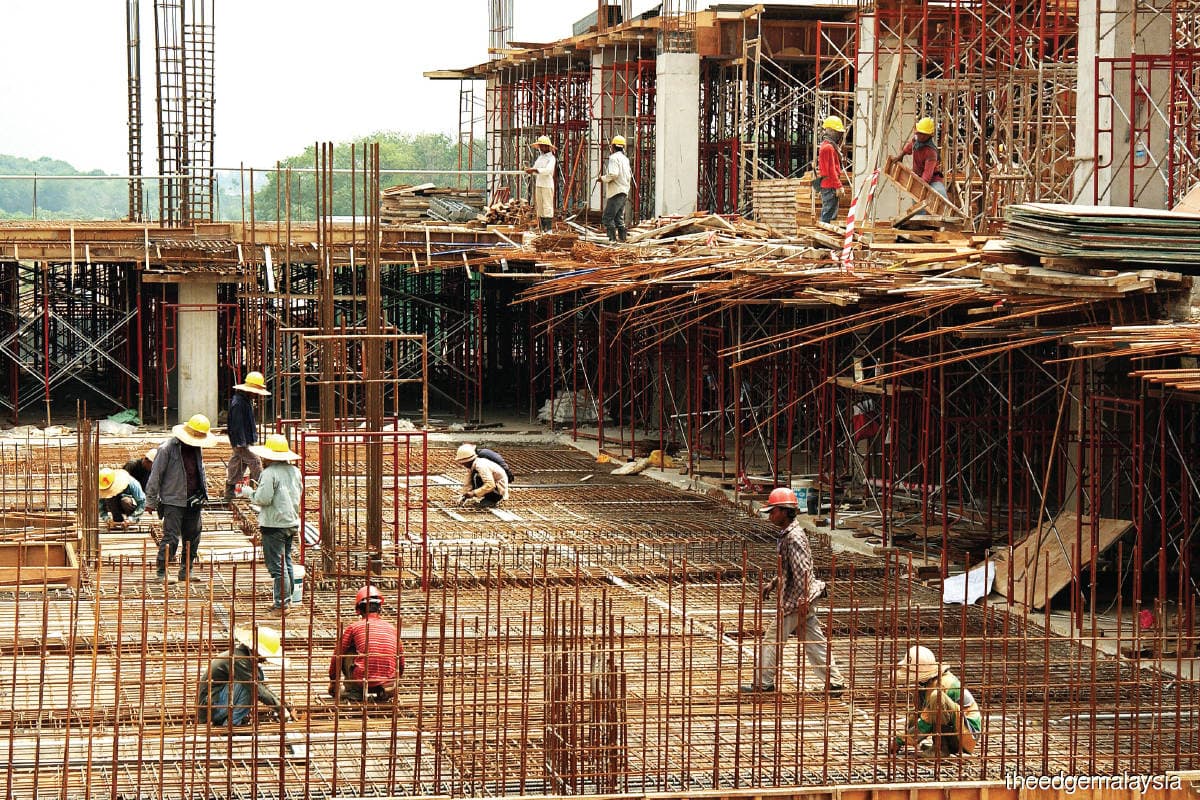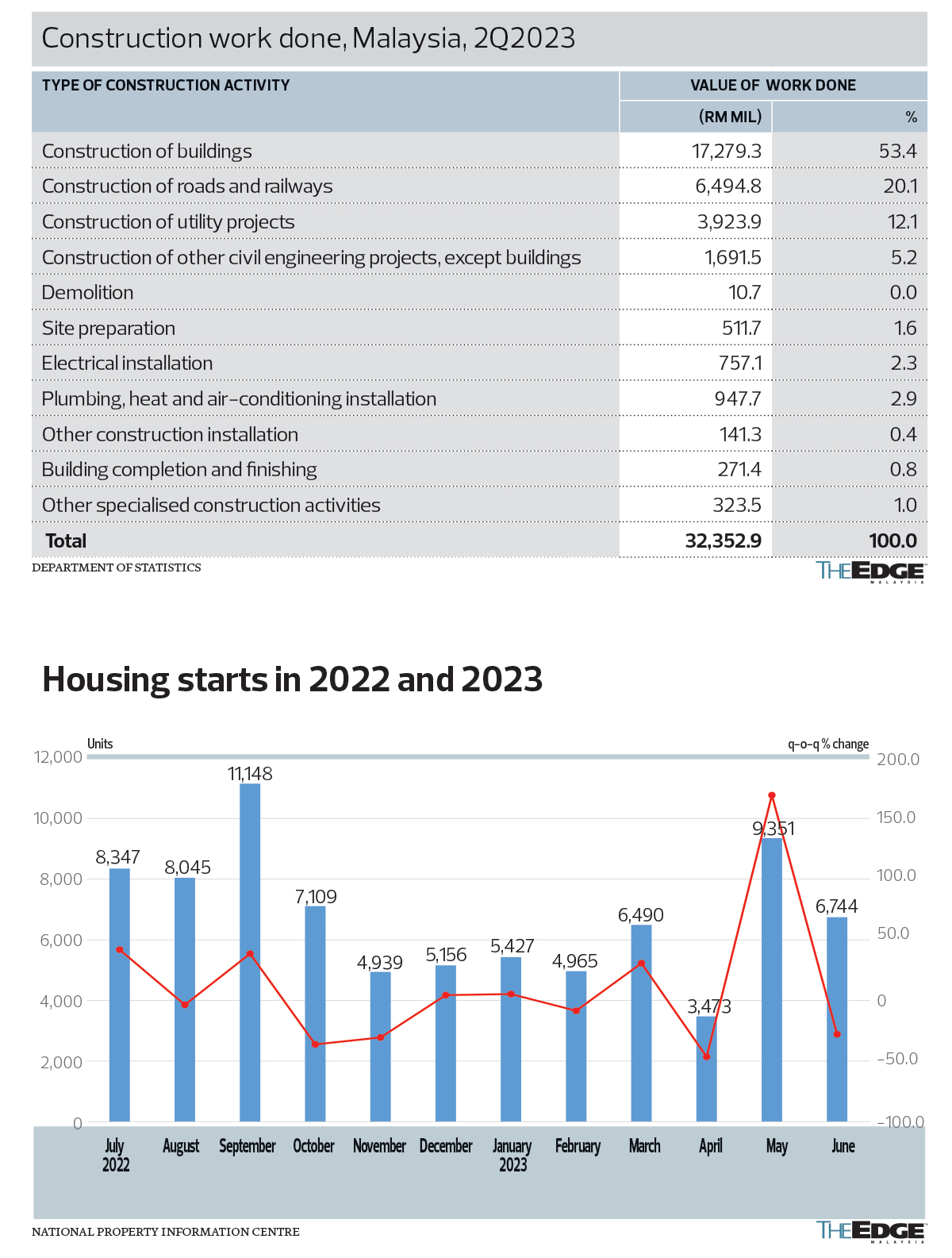
This article first appeared in Capital, The Edge Malaysia Weekly on September 25, 2023 - October 1, 2023
CONSTRUCTION stocks on Bursa Malaysia have attracted interest this year, with the KL Construction Index rising 20.52% year to date (YTD), reaching a two-year high and outperforming the FBM KLCI.
This comes at a time when many construction companies are struggling as a result of the low number of contracts being dished out so far this year. According to Master Builders Association of Malaysia (MBAM) president Oliver Wee, contract wins as at September amounted to RM78 billion.
“We are expecting that contract wins this year [will] amount to RM150 billion, higher than last year’s RM130 billion. Up to September, however, only RM78 billion has been dished out, which means we are two months behind schedule,” Wee tells The Edge.
Annualised, construction contracts would reach RM104 billion, 20% lower than the total in 2022. So, what could be driving the optimism in construction stocks?
An area that has attracted investor interest is the government’s announcement of the development of Johor as a special economic and financial zone.
“I think it is mostly the Johor play,” says Kerjaya Prospek Group Bhd non-executive chairman Datuk Tee Eng Ho. “Property sales have also been moving, and because people have been holding up [from investing], and when they see property sales moving, they look at construction companies as beneficiaries.”
His views are echoed by Crest Builder Holdings Bhd group managing director Eric Yong, who believes the share price rally is mostly among the counters seen as beneficiaries of the development of the Johor-Singapore Special Economic Zone (SEZ).
“When you look at the companies that had their share prices rallying, you immediately see the southern players,” says Yong, noting that companies such as Ekovest Bhd and property developers Iskandar Waterfront City Bhd (IWCity) and UEM Sunrise Bhd are among the biggest winners.
As at last Wednesday, Ekovest’s share price had rallied more than 62% YTD to 57 sen; UEM Sunrise’s share price had rallied 250% YTD to 91 sen; and IWCity’s share price had surged 177.78% YTD to 75 sen.
The rally coincided with the government’s announcement of more details of the SEZ.
In a joint press conference in July, Minister of Economy Rafizi Ramli and Singapore’s National Development Minister Desmond Lee announced that a special task force had been set up to study the establishment of the Johor-Singapore SEZ. Following the announcement, the share prices of “Johor counters” started to rally.
The rally was given a further leg up when, on Sept 14, Johor Menteri Besar Datuk Onn Hafiz Ghazi told the state assembly that Malaysia and Singapore were expected to finalise the terms of reference of the proposed SEZ at the Leaders’ Retreat in the city state next month.
Then, the government recently announced that it would allocate RM90 billion a year for development expenditure (DE) between 2023 and 2025, as part of the 12th Malaysia Plan (12MP). All this is good news for construction players.
The rally is focused however, more on construction companies outside the “Big 3” — Gamuda Bhd, IJM Corp Bhd and Sunway Construction Group Bhd. The big winners include Ahmad Zaki Resources Bhd (AZRB), Econpile Holdings Bhd, Naim Holdings Bhd and LFE Corp Bhd.
While Gamuda’s share price has risen 16.67% YTD, AZRB saw its share price rally 56.25% to 25 sen as at last Wednesday. IJM’s share price rose 21.02% to RM1.90, but Econpile’s share price almost doubled YTD to 31 sen as at last Wednesday.
“Property sales have also been picking up, especially for projects that cater for local demand and are by strong developers,” says Crest Builder’s Yong. “Meanwhile, the weak ringgit has also made investing in Malaysian stocks more attractive to foreign investors.”
In a report on fund flows into Malaysian equities for the week ended Sept 15, MIDF Amanah Investment Bank says the top three sectors with net foreign inflows during the week were utilities, at RM105.5 million, followed by construction at RM53.6 million.
Property sales inching up but …
While data from the National Property Information Centre (Napic) shows that the number of property transactions has been increasing since 2021, it cannot be ascertained as to whether they are mostly from newly launched products.
MBAM’s Wee says if most of the property sales are from existing stock, then they would not translate into many contracts for the construction players. MBAM’s figure of RM78 billion in contracts dished out as at September confirms this point.
According to Napic, residential property transactions jumped 26.26% year on year in the first half of 2022 (1H2022) to 116,178. It was only 114,973 in 1H2023, corresponding to a marginal decline of 1.04% y-o-y.
Total residential property transactions in 1H2023 was RM44.78 billion, compared with RM45.62 billion in 1H2022.
The number of commercial property transactions continued to increase in 1H2023, rising by 16.05% y-o-y to 17,602, after jumping 45.38% in 1H2022. As much as RM16.76 billion worth of commercial properties were transacted in 1H2023, compared with RM14.11 billion in 1H2022.
In terms of housing starts, the numbers fluctuated in 1H2023. The number of new houses that had begun to be constructed reached a peak of 9,351 units in May 2023, a huge jump from 3,473 in April, but fell to 6,744 in June.
These numbers show that the property market is still not totally out of the woods, although some light can be seen at the end of the tunnel, according to the rising trend of housing starts in 1H2023, compared with the declining trend in the second half last year (see chart).
Nevertheless, the private sector is only half of the equation when it comes to construction jobs. The other half is government spending on infrastructure development.
MBAM’s Wee urges the government to quickly roll out the DE planned under the 12MP, which will translate into more jobs for construction players. For some of these projects, such as the MRT Circle Line in Kuala Lumpur and the Penang LRT, the land acquisition process could take time. He says: “While the income [of construction contracts] is fixed, the costs are not, and they may escalate as and when the government awards the tenders for the big infrastructure projects, because demand for the materials will increase and so will prices.”
Therefore, the longer the land acquisition process takes after the awarding of the contracts, the higher the costs will be, and the contractors are usually the ones who will have to pick up the tab, he adds.
Positive outlook, but productivity and materials cost challenges remain
Looking at construction company earnings, of the 74 listed players, 29 reported a net loss in the quarter ended June 30, 2023, some 35 reported lower earnings than a year ago, and 34 reported earnings less than in the preceding quarter. Still, construction players have a positive outlook on the sector.
For example, Kerjaya Prospek’s Tee says he can see the group reporting good results in FY2025/26, based on the contracts it has right now.
As at Sept 1, Kerjaya Prospek had secured RM1.1 billion in new contracts, with its outstanding order book totalling RM4.6 billion. According to PublicInvest Research, the outstanding order book would provide earnings visibility for the next three to four years for Kerjaya Prospek.
Mercury Securities has a “buy” call on Kerjaya Prospek, with a target price of RM1.46, while PublicInvest Research has an “outperform” call on the counter with a target price of RM1.55. Kerjaya Prospek’s share price has increased 8.55% YTD to RM1.27.
MBAM’s Wee also has positive outlook on the construction sector, especially with the anticipated MRT3 and news flow that the KL-Singapore High Speed Rail could make a comeback. Nevertheless, rising materials cost and labour productivity issues could be a challenge for the industry.
Kerjaya Prospek’s Tee concurs, saying that foreign workers who have 10 years’ experience either are being repatriated or do not wish to return to Malaysia because of the competitive wages offered in their home countries.
“So, we had to train new workers and this affected labour productivity,” says Tee.
To address this issue, Wee says, contractors have been encouraged to adopt more digitalisation and automation. This option requires substantial investments, however, that few are willing to undertake.
“We have been asking for grants from the government, such as matching grants, to help our members automate and digitalise. So far, the feedback has not been positive,” says Wee.
At the same time, he urges the government to start implementing the new Standard Form of Contract for Building Works 2022 (CIDB 2022), which emphasises the sharing of risk between developers or project owners and contractors. This is so that projects will not be abandoned if contractors find themselves unable to cope with the rising prices of materials and other liabilities that could jeopardise the performance of the project, he says.
With political uncertainty taken a notch lower, as the state elections concluded in August, the government can now focus on delivering on its promises to the people. The 12MP and other policies are also being implemented to ensure that the economy continues to grow over the next three years.
Meanwhile, all eyes will be on whether the rally in construction stocks has legs.
RHB Research is “overweight” on the sector, with its top picks being MRCB (target price of 55 sen), Sunway Construction (TP: RM2.22) and Kerjaya Prospek (TP: RM1.50). CIMB-CGS is also bullish on the sector and has highlighted Malayan Cement Bhd (TP: RM5.55) and YTL Corp Bhd (TP: RM1.91) as top picks.
Maybank Investment Bank Research and UOB Kayhian are “neutral” on the sector, but the latter likes Gamuda (TP: RM5.14), Gabungan AQRS Bhd (TP: 48 sen), Kerjaya Prospek (TP: RM1.54) and WCT Holdings Bhd (TP: 69 sen).
Save by subscribing to us for your print and/or digital copy.
P/S: The Edge is also available on Apple's App Store and Android's Google Play.

